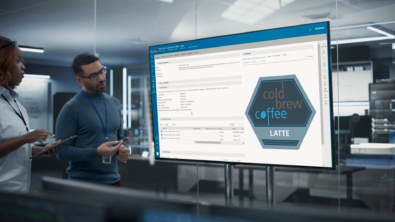Webinar highlights: Accelerate consumer packaged goods innovation with consumer centricity

Navigating innovation and consumer expectations in the consumer packaged goods industry
In today’s fast-paced consumer packaged goods (CPG) industry, staying ahead of the curve is crucial. This blog explores the challenges companies face as they navigate product development in a highly competitive market. We’ll look at strategies to align closely with consumer expectations, adapt to evolving regulatory landscapes, and leverage technological advancements, including integrated lifecycle management tools, to improve product lifecycle management and market responsiveness.
Product innovation in consumer packaged goods: Insights from our webinar
Our recent webinar co-hosted with Accenture, offered a deep dive into product innovation within the consumer packaged goods sector. Imagine developing around 75,000 products annually, yet seeing only about 40% reach the market, and an astonishing 95% of those failing to sustain their presence. This alarming rate highlights the urgent need for innovative approaches to enhance product success and longevity. By adopting new strategies, you can transform these challenges into opportunities for growth.
An integrated system with product lifecycle and program management can streamline product development, helping reduce time-to-market and increase success rates.
The Impact of consumer feedback on product innovation
Understanding consumer demands and preferences is vital in the CPG sector. Picture this: direct consumer feedback significantly influences product features and development, driving companies to integrate consumer insights more deeply into the innovation process. Rapid adaptation to consumer needs is essential in this dynamic market environment. Advanced digital tools, including integrated lifecycle management, enable quicker integration of consumer feedback into product development, shortening the typical innovation cycle from 12 to 18 months. This agility not only meets current demands but also sets the stage for future innovations. Integrated digital solutions facilitate seamless feedback integration, ensuring your products meet and exceed consumer expectations.
Navigating the challenges of seamless consumer experiences across multiple platforms
Providing a seamless consumer experience across e-commerce, social media, and brick-and-mortar stores is challenging yet critical. Think about the last time you experienced a brand both online and in-store. Maintaining a consistent brand experience both online and offline can be tough. Effective multi-platform marketing and sales strategies are essential for success. Integrating digital tools can streamline processes, reduce the product innovation cycle, and enhance the consumer experience across various platforms. Imagine the possibilities when every touchpoint delivers a cohesive and satisfying experience for your customers. Solutions that ensure all consumer touchpoints are synchronized can provide a consistent and engaging brand experience.
Check out this clip from our most recent webinar for a deeper dive.
Navigating the evolving regulatory landscape in product development
The regulatory landscape is constantly changing, with new rules introduced regularly. Companies must stay updated and proactively anticipate these changes. Consider the complexity of bringing a product to market with 75,000 developed annually and only 40% making it through stringent regulatory conditions. Proactive compliance and integrating regulatory strategies into core business processes are essential for smoother transitions from development to successful market entry. Staying ahead of regulations not only ensures compliance but also positions you as a leader ready to tackle future challenges. Leveraging regulatory compliance solutions is key to helping you stay ahead of changing regulations, ensuring your products meet all necessary standards.
“We’re seeing an evolving and changing regulatory landscape. New regulations are appearing all the time and our customers need to be able to keep on top of those.”
The impact of brand authenticity and product origin on consumer trust
Brand authenticity and product origin are increasingly important as consumers demand transparency regarding product origins. Consumers today want to know where their products come from and how they are made. Strategies to enhance brand authenticity include providing clear information about materials and processes used in manufacturing, fostering consumer trust and brand loyalty. Imagine the trust and loyalty you can build by being open and transparent with your consumers. By implementing an integrated PLM solution, you can build a data and collaboration system that enables your entire organization to work as a single team, in real time, with one source of truth: from design to prototyping to testing to manufacturing and beyond for full transparency.
The rise of hyper-personalization in consumer goods
Hyper-personalization is a pivotal trend in the consumer goods landscape. Technological advancements enable the personalization of products, allowing manufacturers to create smaller, targeted batches that cater precisely to consumer preferences. Advanced digital tools facilitate a more agile product development process, helping brands meet the diverse needs of their customers. Visualize a future where every product feels tailor-made for each customer, enhancing satisfaction and loyalty. Flexible manufacturing execution solutions enable rapid hyper-personalization at scale, ensuring each product meets individual consumer preferences.
The increasing influence of activist consumers on product innovation
Environmentally sustainable products are increasingly expected by consumers, influenced by activist consumers who demand products that positively impact the environment. These demands push brands to innovate while incorporating sustainable practices. Strategies to align products with activist consumer values include integrating sustainable practices from the design phase and ensuring transparency in sourcing and production processes. By adopting these practices, you not only meet current demands but also contribute to a more sustainable future from design to production.
Transforming consumer engagement with smart packaging innovations
Innovative smart packaging technologies enhance consumer engagement and streamline product tracking. Imagine packaging that not only protects your product but also interacts with your customers. Smart packaging connects with consumers in an interactive manner, offering enriched product information and personalized experiences. This approach fosters greater consumer loyalty and provides brands with invaluable data to tailor marketing strategies. It’s about more than just packaging; it’s about creating a memorable customer journey. Implementing smart packaging technologies can provide these interactive features and real-time tracking, boosting both consumer engagement and brand loyalty.
Watch the full webinar
Don’t miss out on these critical insights—watch the full webinar now to transform your approach to CPG innovation! Discover how leading companies are accelerating innovation and driving success in the consumer packaged goods industry. Join us and envision a future where your products lead the market with innovation and consumer centricity.


